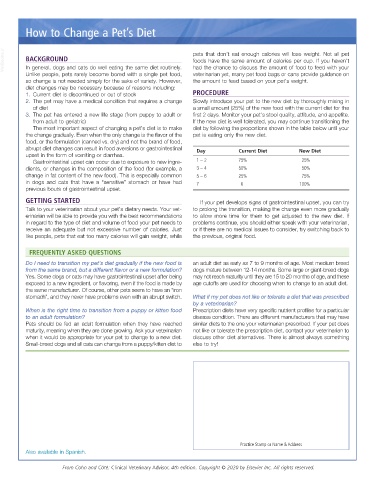Page 3178 - Cote clinical veterinary advisor dogs and cats 4th
P. 3178
How to Change a Pet’s Diet
VetBooks.ir BACKGROUND pets that don’t eat enough calories will lose weight. Not all pet
foods have the same amount of calories per cup. If you haven’t
had the chance to discuss the amount of food to feed with your
In general, dogs and cats do well eating the same diet routinely.
Unlike people, pets rarely become bored with a single pet food, veterinarian yet, many pet food bags or cans provide guidance on
so change is not needed simply for the sake of variety. However, the amount to feed based on your pet’s weight.
diet changes may be necessary because of reasons including:
1. Current diet is discontinued or out of stock PROCEDURE
2. The pet may have a medical condition that requires a change Slowly introduce your pet to the new diet by thoroughly mixing in
of diet a small amount (25%) of the new food with the current diet for the
3. The pet has entered a new life stage (from puppy to adult or first 2 days. Monitor your pet’s stool quality, attitude, and appetite.
from adult to geriatric) If the new diet is well tolerated, you may continue transitioning the
The most important aspect of changing a pet’s diet is to make diet by following the proportions shown in the table below until your
the change gradually. Even when the only change is the flavor of the pet is eating only the new diet.
food, or the formulation (canned vs. dry) and not the brand of food,
abrupt diet changes can result in food aversions or gastrointestinal Day Current Diet New Diet
upset in the form of vomiting or diarrhea.
Gastrointestinal upset can occur due to exposure to new ingre- 1 – 2 75% 25%
dients, or changes in the composition of the food (for example, a 3 – 4 50% 50%
change in fat content of the new food). This is especially common 5 – 6 25% 75%
in dogs and cats that have a “sensitive” stomach or have had 7 0 100%
previous bouts of gastrointestinal upset.
GETTING STARTED If your pet develops signs of gastrointestinal upset, you can try
Talk to your veterinarian about your pet’s dietary needs. Your vet- to prolong the transition, making the change even more gradually
erinarian will be able to provide you with the best recommendations to allow more time for them to get adjusted to the new diet. If
in regard to the type of diet and volume of food your pet needs to problems continue, you should either speak with your veterinarian,
receive an adequate but not excessive number of calories. Just or if there are no medical issues to consider, try switching back to
like people, pets that eat too many calories will gain weight, while the previous, original food.
FREQUENTLY ASKED QUESTIONS
Do I need to transition my pet’s diet gradually if the new food is an adult diet as early as 7 to 9 months of age. Most medium breed
from the same brand, but a different flavor or a new formulation? dogs mature between 12-14 months. Some large or giant-breed dogs
Yes. Some dogs or cats may have gastrointestinal upset after being may not reach maturity until they are 15 to 20 months of age, and these
exposed to a new ingredient, or flavoring, even if the food is made by age cutoffs are used for choosing when to change to an adult diet.
the same manufacturer. Of course, other pets seem to have an “iron
stomach”, and they never have problems even with an abrupt switch. What if my pet does not like or tolerate a diet that was prescribed
by a veterinarian?
When is the right time to transition from a puppy or kitten food Prescription diets have very specific nutrient profiles for a particular
to an adult formulation? disease condition. There are different manufacturers that may have
Pets should be fed an adult formulation when they have reached similar diets to the one your veterinarian prescribed. If your pet does
maturity, meaning when they are done growing. Ask your veterinarian not like or tolerate the prescription diet, contact your veterinarian to
when it would be appropriate for your pet to change to a new diet. discuss other diet alternatives. There is almost always something
Small-breed dogs and all cats can change from a puppy/kitten diet to else to try!
Practice Stamp or Name & Address
Also available in Spanish.
From Cohn and Côté: Clinical Veterinary Advisor, 4th edition. Copyright © 2020 by Elsevier Inc. All rights reserved.

